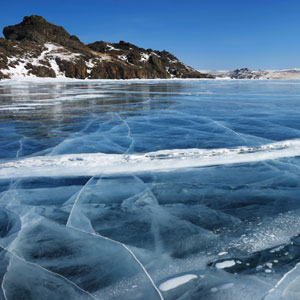
|
|
Floating ice insulates the water beneath it, helping prevent most large bodies of water from freezing solid. Source: iStock |
As drillers, we use many chemical compounds on a daily basis. Drilling mud, acids and surfactants are all items utilized in the drilling industry. Many of these chemicals can be potentially hazardous to our health. One of the most common chemical compounds we use is tasteless, odorless, colorless and in its pure form can dissolve almost everything on the planet. This chemical is deadly if we breathe it or drink too much of it. What compound am I describing? The International Union of Pure and Applied Chemistry has named this substance “oxidane.” Other names are hydrogen oxide and, in pranks, dihydrogen monoxide (DHMO). Its most common name: water.
A water molecule has a very simple atomic structure. It consists of two hydrogen atoms covalently bonded to one oxygen atom. But, instead of focusing on the atomic structure of water, let’s discuss some of the interesting and unique physical properties.
• Water is the only common substance to exist naturally in all three states of matter: liquid, gas and solid.
• Water has a density of about one gram per cubic centimeter. However, the density of water is based on temperature and here is where things get interesting. Think about a lake in the winter. As the body of water cools, its density increases. When the temperature of the water reaches about 4 degrees Celsius, the entire lake has the same density. As the temperature of the water reaches 0 degrees (the freezing point of water) ice forms. This is the “cool” part; ice is about 9 percent LESS dense than water, which means ice floats. Just think what would happen if a lake froze all at once, or from the bottom up? All life in the lake would be frozen in a giant block of ice. Even more interesting, the floating ice acts as insulation, dramatically slowing the cooling of the water under the ice and preventing most large bodies of water from freezing completely.
• Pure water, which is never found in nature, does not conduct electricity. Unfortunately dissolved solids, think salt, in water allow electrical current to travel through the liquid. And, as we all know, all water in nature contains dissolved solids. While this may be dangerous and potentially deadly for humans, it allows biologists to study fish in streams and lakes. The scientists introduce an electrical current into a stream or lake, which stuns the fish and brings them to the surface for study.
• Water is called the universal solvent because it dissolves more substances than any other liquid. However, just because it is called the universal solvent, water does not dissolve everything. If it did, how would we store it or drink out of a cup?
• Water weighs about 8.33 pounds per gallon or about 62.4 pounds per cubic foot. If you think about the volume of water moving in an ocean wave or through a stream, it is no wonder that floods and storms cause damage.
As drillers, our goal is to provide fresh clean water to our clients; sometimes, it’s best to sit back and think about the product we provide from a different point of view.




Report Abusive Comment